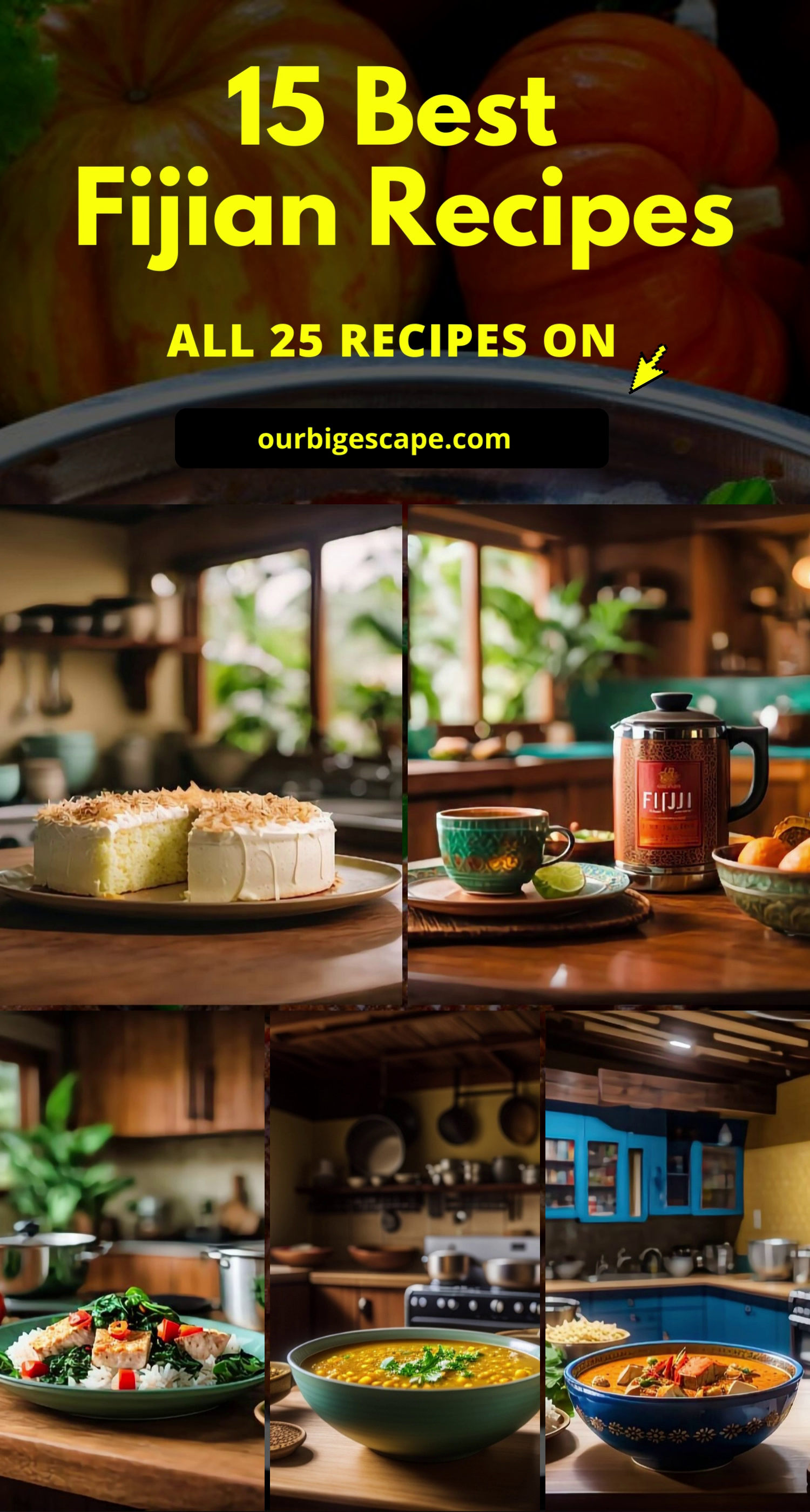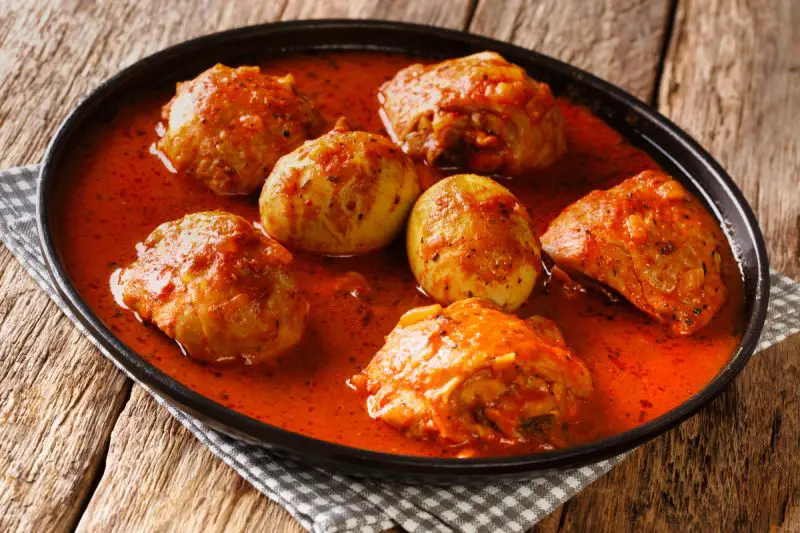
The Fijian Seafood Curry Recipe is a dish that combines seafood, spinach, and rice in a flavorful and nutritious meal. This dish is known for its taste and health benefits.
A Fijian Seafood Curry Recipe is a traditional Fijian recipe that brings together the rich flavors of seafood, the earthy taste of spinach, and the filling quality of rice. It is a popular dish in Fiji and is enjoyed by many for its simplicity and deliciousness.
You May Want to Join The World Recipes With Our Big Escape
Share your own recipes in our Facebook Group. Find recipes from all over the world. Learn more about International Cuisine and how you can surprise your family with new and exciting foods from all over the world.
For More Photos Visit Our Instagram at World Recipes Daily
The combination of seafood in this dish provides a good source of protein. Seafood is also rich in omega-3 fatty acids, which are known to be beneficial for heart health. Spinach, on the other hand, adds a healthy dose of vitamins and minerals to the meal, including vitamin A, vitamin C, and iron. These nutrients are essential for maintaining good health.
Rice serves as the base of the dish and provides carbohydrates, which are an important source of energy for the body. It complements the seafood and spinach, creating a satisfying and well-balanced meal.
In summary, the Fijian Seafood Curry Recipe is a traditional Fijian dish that combines seafood, spinach, and rice in a nutritious and flavorful way. It offers a good source of protein, omega-3 fatty acids, vitamins, and minerals, making it a healthy choice for those looking to enjoy a delicious and nourishing meal.

How To Make Our The Fiji Seafood Curry Recipe
Ingredients (8 Servings)
Coconut oil for frying
2 large yellow or white onion, peeled and diced
3 cloves garlic, minced
2 teaspoon ground cumin
2 teaspoon yellow mustard seeds
2 tablespoon curry powder
2 teaspoon turmeric powder
4 tablespoons tomato paste
4 tablespoons oyster sauce
2 Tbsp Piquant Post Fijian Masala
1 tsp sriracha, optional for heat
1 can coconut milk 14 oz.
2 lbs. mixed seafood (I used peeled prawns and ling fish cut into bite sized pieces)
Salt and pepper
Instructions
1. Heat coconut oil for frying in a large skillet over medium heat.
a. Dice 2 large yellow or white onions and add them to the skillet.
b. Sauté the onions until they turn translucent and develop a slight caramelization.
c. Minimize the heat, and add 3 cloves of minced garlic to the skillet. Cook for an additional minute.
2. Into the skillet, incorporate 2 teaspoons of ground cumin and 2 teaspoons of yellow mustard seeds.
a. Toast the spices for 1-2 minutes until they release their fragrance.
b. Blend in 2 tablespoons of curry powder and 2 teaspoons of turmeric powder.
3. Mix in 4 tablespoons of tomato paste, 4 tablespoons of oyster sauce, and 2 tablespoons of Piquant Post Fijian Masala.
a. Ensure all the ingredients are well combined.
b. For a spicier option, you can add 1 teaspoon of sriracha.
4. Pour a 14 oz. can of coconut milk into the skillet.
a. Stir the mixture until the sauce becomes smooth.
b. Bring it to a simmer and let it cook for 5-7 minutes, allowing the flavors to meld.
c. Season the sauce with salt and pepper to taste.
5. Add 2 pounds of mixed seafood, including peeled prawns and ling fish cut into bite-sized pieces, to the skillet.
a. Gently stir to coat the seafood with the curry sauce.
b. Continue simmering for 5-7 minutes, or until the seafood is fully cooked.
6. In a separate pot, prepare rice according to your preferred method.
a. Serve the Fijian Seafood Curry over the cooked rice.
b. Optionally, garnish with fresh spinach leaves for added freshness.
Estimated prep time: 15 minutes
Estimated cooking time: 25 minutes

Pots, Pan and Cooking Equipment Needed for the The Fijian Seafood Curry Recipe
Large Stew Pot
Best Way to Store Leftovers From The Recipe
a. Store leftovers in airtight containers to maintain freshness.
b. Refrigerate within 2 hours of cooking to prevent bacterial growth.
c. Label containers with the date to track freshness.
d. Consume leftovers within 3-4 days for optimal taste and safety.
e. Reheat in a microwave or on the stovetop until piping hot.
f. Do not refreeze previously frozen leftovers.
Tips and Tricks For Easier Creation
Use fresh seafood for the best flavor.
Adjust the level of sriracha for desired spiciness.
Customize the seafood mix to your preferences.
Freshly squeezed lime juice can add a zesty twist.
Substitute spinach with other greens if preferred.
Make extra sauce for a saucier dish.
Garnish with fresh cilantro for extra freshness.
Side Dishes and Desserts Forthe The Fijian Seafood Curry Recipe
a. Steamed jasmine rice
b. Naan bread for scooping up the curry
c. Fresh cucumber salad with yogurt dressing
d. Mango chutney for a sweet contrast
e. Sliced ripe avocado with lime and salt
f. Coconut-flavored quinoa
g. Grilled pineapple skewers
How To Serve the Cuban The Fijian Seafood Curry Recipe
a. Ladle the Fijian Seafood Curry over a bed of cooked rice.
b. Place a handful of fresh spinach leaves on top for garnish.
c. Serve with your choice of side dishes.
d. Provide lime wedges for an extra burst of flavor.
e. Enjoy the meal family-style or plated individually.
f. Pair with a cold beverage of your choice.
Dietary Substitution For the The Fijian Seafood Curry Recipe
1. Vegan Options for the Fijian Seafood Curry Recipe:
a. Substitute seafood with firm tofu or tempeh.
b. Replace oyster sauce with a vegan-friendly soy sauce or mushroom sauce.
c. Use a plant-based alternative to coconut milk.
d. Swap honey for maple syrup as a sweetener.
e. Replace fish sauce with a vegan fish sauce alternative.
2. Gluten-Free Options for the Fijian Seafood Curry Recipe:
a. Ensure that the curry powder and mustard seeds are gluten-free.
b. Use gluten-free soy sauce instead of oyster sauce.
c. Choose a gluten-free tomato paste brand.
d. Verify that the sriracha sauce is gluten-free.
e. Serve the curry with gluten-free rice or rice noodles.
3. Vegetarian Options for the Fijian Seafood Curry Recipe:
a. Substitute seafood with extra vegetables like mushrooms, bell peppers, and zucchini.
b. Replace oyster sauce with vegetarian oyster sauce or hoisin sauce.
c. Use a vegetable-based coconut milk alternative.
d. Swap honey for agave nectar as a sweetener.
e. Replace fish sauce with a vegetarian fish sauce alternative.
4. Mediterranean Diet Options for the Fijian Seafood Curry Recipe:
a. Include more Mediterranean-style seafood such as shrimp and calamari.
b. Use olive oil instead of coconut oil for frying.
c. Replace curry powder with Mediterranean spices like oregano and thyme.
d. Serve the curry over couscous or quinoa.
e. Garnish with fresh herbs like basil and parsley.
5. Keto Diet Options for the Fijian Seafood Curry Recipe:
a. Use ghee instead of coconut oil for frying.
b. Replace tomato paste with crushed tomatoes for lower carb content.
c. Substitute the rice with cauliflower rice.
d. Ensure that the curry powder and mustard seeds are low in carbs.
e. Serve with a side of keto-friendly vegetables like spinach or asparagus.
6. Heart-Healthy Diet Options for the Fijian Seafood Curry Recipe:
a. Use olive oil for frying instead of coconut oil.
b. Choose a low-sodium soy sauce or oyster sauce.
c. Opt for light coconut milk to reduce saturated fat.
d. Replace salt with herbs and spices for seasoning.
e. Include heart-healthy seafood options like salmon and mackerel.
7. Paleo Options for the Fijian Seafood Curry Recipe:
a. Use ghee or coconut oil for frying.
b. Replace tomato paste with crushed tomatoes.
c. Substitute the rice with cauliflower rice.
d. Ensure that the curry powder and mustard seeds are paleo-friendly.
e. Serve with a side of paleo-approved vegetables like broccoli or kale.
8. Low Carb Options for the Fijian Seafood Curry Recipe:
a. Use olive oil for frying to keep the dish low in carbs.
b. Choose a low-carb soy sauce or oyster sauce.
c. Substitute the rice with cauliflower rice or shirataki noodles.
d. Ensure that the curry powder and mustard seeds are low in carbs.
e. Serve with low-carb vegetables like broccoli and bell peppers.
9. Whole 30 Options for the Fijian Seafood Curry Recipe:
a. Use ghee or olive oil for frying.
b. Replace tomato paste with crushed tomatoes without added sugar.
c. Choose a Whole30-compliant hot sauce instead of sriracha.
d. Ensure that the curry powder and mustard seeds are Whole30-friendly.
e. Serve the curry with cauliflower rice or sweet potato noodles.
10. Weight Watchers Options for the Fijian Seafood Curry Recipe:
a. Use cooking spray instead of coconut oil for frying to reduce points.
b. Choose low-sodium soy sauce or oyster sauce to lower points.
c. Opt for light coconut milk to reduce points.
d. Serve the curry with cauliflower rice to save points.
e. Use a sugar-free sweetener to lower the points from honey.
11. Low-Fat Options for the Fijian Seafood Curry Recipe:
a. Use a minimal amount of oil for frying or consider a non-stick cooking spray.
b. Replace full-fat coconut milk with light coconut milk.
c. Choose a low-fat soy sauce or oyster sauce.
d. Serve with steamed or sautéed vegetables for a lower fat content.
e. Use a lean white fish like cod instead of fattier seafood options.
12. Vegetable Variations for the Fijian Seafood Curry Recipe:
a. Include a variety of vegetables such as bell peppers, carrots, and snap peas.
b. Use vegetable broth instead of coconut milk for a lighter version.
c. Consider adding chickpeas or lentils for extra protein and texture.
d. Use vegetable-based protein alternatives like seitan or tofu.
e. Customize the vegetables based on personal preferences and seasonal availability.
It’s always recommended to check labels, choose quality ingredients, and consult with a healthcare professional or registered dietitian for personalized advice.

FAQ About the Fijian Seafood Curry Recipe
What is the main ingredient in a Fijian Seafood Curry Recipe?
Coconut milk is a key ingredient in Fijian Seafood Curry recipe.
Can I substitute seafood in a Fijian Seafood Curry Recipe for other proteins?
Yes, you can substitute seafood with tofu, tempeh, or meat alternatives for a vegetarian version.
Is this Fijian Seafood Curry Recipe recipe gluten-free?
To ensure it’s gluten-free, use gluten-free curry powder and tamari sauce.
How can I make this Fijian Seafood Curry Recipe keto-friendly?
For a keto version of the Fijian Seafood Curry recipe, use cauliflower rice instead of regular rice and check the carb content of curry powder and other seasonings.
What is a suitable low-fat option for a Fijian Seafood Curry Recipe?
To reduce fat in the Fijian Seafood Curry recipe, use cooking spray instead of coconut oil and opt for low-fat yogurt instead of coconut milk.
Final Thoughts
The Fijian Seafood Curry Recipe is a flavorful dish featuring a rich and creamy coconut milk base infused with aromatic spices like cumin, mustard seeds, curry powder, and turmeric. This delectable curry incorporates a variety of mixed seafood, such as prawns and ling fish, creating a diverse range of flavors and textures.
It offers a delightful balance of savory and mildly spicy notes, with the optional addition of sriracha for those who prefer extra heat. Served alongside spinach and rice, this dish provides a satisfying and wholesome meal that showcases the vibrant and authentic flavors of Fijian cuisine.
Fijian Seafood Curry Recipe
Equipment
- Large Stew Pot
Ingredients
- Coconut oil for frying
- 2 onion peeled and diced
- 3 cloves garlic minced
- 2 teaspoon ground cumin
- 2 teaspoon yellow mustard seeds
- 2 tablespoon curry powder
- 2 teaspoon turmeric powder
- 4 tablespoons tomato paste
- 4 tablespoons oyster sauce
- 2 Tbsp Masala Piquant Post Fijian
- 1 tsp sriracha optional for heat
- 1 can coconut milk
- 2 lbs. prawns I used peeled prawns and ling fish cut into bite sized pieces
- Salt and pepper
Instructions
Heat coconut oil for frying in a large skillet over medium heat.
- a. Dice 2 large yellow or white onions and add them to the skillet.
- b. Sauté the onions until they turn translucent and develop a slight caramelization.
- c. Minimize the heat, and add 3 cloves of minced garlic to the skillet. Cook for an additional minute.
Into the skillet, incorporate 2 teaspoons of ground cumin and 2 teaspoons of yellow mustard seeds.
- a. Toast the spices for 1-2 minutes until they release their fragrance.
- b. Blend in 2 tablespoons of curry powder and 2 teaspoons of turmeric powder.
Mix in 4 tablespoons of tomato paste, 4 tablespoons of oyster sauce, and 2 tablespoons of Piquant Post Fijian Masala.
- a. Ensure all the ingredients are well combined.
- b. For a spicier option, you can add 1 teaspoon of sriracha.
Pour a 14 oz. can of coconut milk into the skillet.
- a. Stir the mixture until the sauce becomes smooth.
- b. Bring it to a simmer and let it cook for 5-7 minutes, allowing the flavors to meld.
- c. Season the sauce with salt and pepper to taste.
Add 2 pounds of mixed seafood, including peeled prawns and ling fish cut into bite-sized pieces, to the skillet.
- a. Gently stir to coat the seafood with the curry sauce.
- b. Continue simmering for 5-7 minutes, or until the seafood is fully cooked.
In a separate pot, prepare rice according to your preferred method.
- a. Serve the Fijian Seafood Curry over the cooked rice.
- b. Optionally, garnish with fresh spinach leaves for added freshness.

